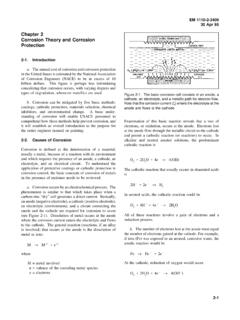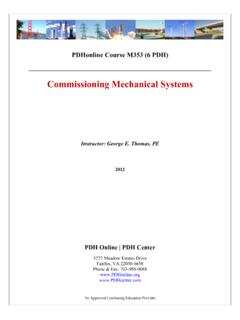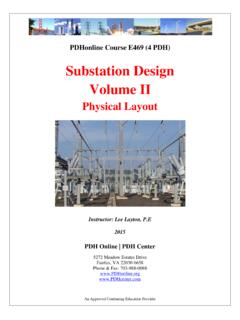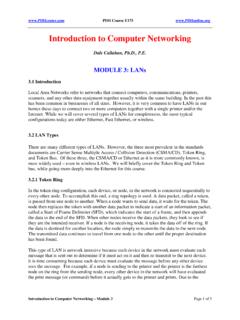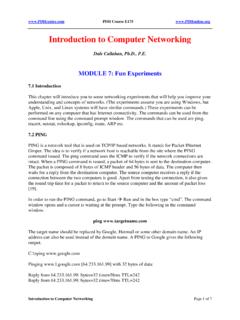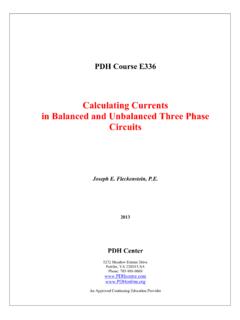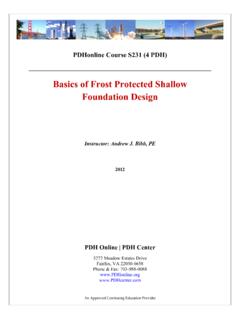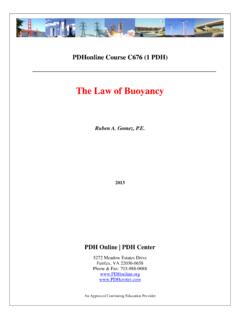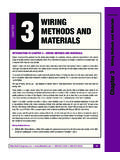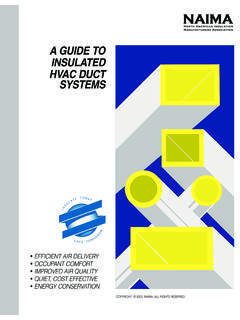Transcription of Conduit Fill Calculations - PDHonline.com
1 PDHonline Course E276 (2 PDH) Conduit fill Calculations2012 Instructor: David A. Snyder, PEPDH Online | PDH Center5272 Meadow Estates DriveFairfax, VA 22030-6658 Phone & Fax: Approved Continuing Education PDH Course E276 Conduit fill Calculations David A. Snyder, PE Introduction: The purpose of this course is to explain Conduit fill , which is just one of the factors to be considered in Conduit sizing. There are other aspects to be considered, as listed in the sidebar. Additional information is also available in PDH Course E122 Conduit system Design by Ralph Fehr, , PE.
2 The tables presented in this document are available as a separate file, if you have difficulty reading the tables in this document. One of the reasons to limit Conduit fill is to allow air to circulate within the Conduit and thereby permit some cooling of the conductors. Conduit fill Calculations , also known as raceway fill Calculations or conductor fill Calculations , are performed to determine the minimum Conduit size required for a given set of conductors. Drawings often describe a circuit as 3-#12, #12 Gnd, C.
3 , without mentioning the type of conductors or the type of Conduit . Typically, the construction specification is where the conductor type and Conduit type are called out for each type of application. The reason we have to know the type of conductor and Conduit is because the physical dimensions are different for different types of conductors and conduits. Different types of conductors with different types of insulation will have different outside diameters for the same wire size. See Figure 6 for the different diameters of a 4/0 AWG conductor with four different insulation types.
4 Table 5 from Chapter 9 of the NEC gives the approximate diameters and areas of different types of conductors, a portion of which is presented as Table 7 in this document, which shows THHW, THHN, THWN, and XHHW. Different types of conduits will have different internal diameters for the same Conduit size. Table 4 from Chapter 9 of the NEC gives the nominal internal diameters and cross-sectional areas for different Conduit types and sizes. Portions of these values are reproduced in Tables 2 through 6 in this document for EMT, IMC, RMC, Schedule 40 PVC, and Schedule 80 PVC.
5 See Figure 5 for an illustration of the different dimensions of a 1 Conduit of these five different types. Conduit fill is often explained by using an example in which all of the conductors are the same size and type. Sometimes, all of the conductors within a Conduit are the same size (such as 12 AWG) and type (such as THHN), but often the conductors will be of different sizes, and occasionally there will be more than one type of conductor in the same Conduit . Annex C in the NEC gives the maximum number of conductors of the same size that will be permitted in various types and sizes of Conduit .
6 Annex C is based on the general case of all of the conductors being the same sizes and type, so Annex C has not been reproduced in this document, since we are David A. Snyder, Conduit fill Calculations Page 2 of 16 These topics are not covered in this short course: Jam ratio see FPN No. 2 to Table 1 in Chapter 9 of the NEC. The de-rating of conductor ampacity based on the number of current-carrying conductors in the same Conduit . Compact conductors (Table 5A in the NEC). Cable pulling tension. Conduit bending radius. Selecting the proper type of Conduit and conductor for a given application.
7 Sizing of boxes and Conduit bodies. Sizing of wireways. PDH Course E276 considering specific cases in which the conductors might be different sizes and types. You can use the techniques from this course to verify the values shown in Annex C, but be sure to consider Note 7 to the tables in Chapter 9 of the NEC, as explained later. Occasionally, a circuit will run through more than one type of Conduit . A common example of this is a circuit that runs in galvanized rigid steel (GRS, sometimes called RGS) above grade, then transitions to Schedule 40 PVC below grade, then back into GRS when it comes above grade again.
8 The Conduit fill Calculations would be slightly different for the two types of Conduit . Conduit fill Calculations are relatively simple and straightforward, but certain details must be known about the Conduit and the conductors. There can be only one unknown from the following five pieces of information in order to perform the Calculations to match the Conduit size with the conductors: Size of Conduit , such as 3 Type of Conduit , such as Schedule 40 PVC Conductor quantities, such as 3-#12 THWN Conductor sizes, such as 3-#12 THWN Conductor types, such as 3-#12 THWN.
9 For multiconductor cables, the last two topics listed above are replaced by using the overall or outside diameter of the cable (it doesn t matter what the sizes and types of the internal conductors are). This document will use different formats interchangeably to describe conductor sizes, such as #12 and 12 AWG. With regard to formulas and Calculations in this document, we will be using the asterisk (*) for multiplication and the forward slash (/) for division. Since we will be discussing diameter (d), rather than radius (r), in this document, the familiar expression for the area of a circle will be shown as A = * d2 / 4, rather than A = * r2.
10 Conduit fill Tables from the NEC: NEC Table 1 in Chapter 9 gives guidelines for Conduit fill , which are represented in Table 1 in this document. David A. Snyder, Conduit fill Calculations Page 3 of 16 PDH Course E276 It might seem from a quick glance at Table 1 that the installation of 2 conductors is being treated unfairly, since 2 conductors can only take up 31% of the Conduit cross-sectional area while 3 conductors can take up 40% of the area and 1 conductor can go all the way up to 53%. The low value of 31% is based partly on geometry, as illustrated in Figure 2, where it is clear that 2 conductors sized to take up a total of 53% of the Conduit cross-sectional area won t even fit in the Conduit .
